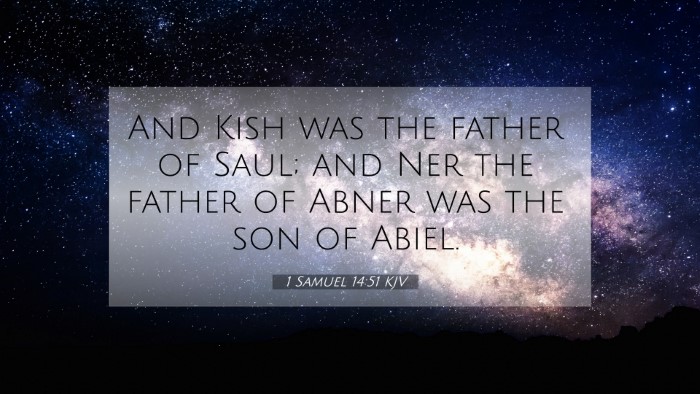Understanding 1 Samuel 14:51
Bible Verse: 1 Samuel 14:51 - "And Kish was the father of Saul; and Ner the father of Abner was the son of Abiel."
This verse provides a brief genealogy that connects pivotal characters in the narrative of Saul, Israel's first king. It serves to establish lineage and the historical context surrounding Saul's rise to power.
Analysis of Key Characters
-
Kish:
Kish's mention as the father of Saul emphasizes Saul's lineage and roots. Kish was a man of wealth and influence, which may predictably lend credence to Saul's eventual kingship.
-
Saul:
Saul's significance in Israel's history is profound, being the first king and a central figure in the transition from theocracy to monarchy in Israel.
-
Ner:
Ner, identified as the father of Abner, is linked to Saul through family ties. This connection highlights the importance of familial relationships in the establishment of power.
-
Abner:
Abner played a crucial role as Saul's commander and served as a significant military leader, deeply influential in the early years of Saul's reign.
-
Abiel:
Abiel's mention provides further depth in familial relations, signifying the intertwining of personal relations and political affairs in Israel's early monarchy.
Thematic Connections
This verse illustrates a foundational moment in Israel’s history, leading to the exploration of themes like:
- Leadership: Examining how familial ties impact leadership within scriptural narratives.
- Divine Selection: Understanding God's choice of Saul, albeit complex, sheds light on His sovereignty in electing leaders.
- Legacy: The genealogical element in this verse signifies the importance of legacy and heritage in biblical times.
Bible Verse Cross-References
Several scriptures relate closely to 1 Samuel 14:51:
- 1 Samuel 9:1-2: This passage discusses Saul's ancestry and physical attributes, emphasizing his stature and family's background.
- 1 Chronicles 8:33-34: Further genealogical detail adds depth, helping to establish continuity in Saul's lineage.
- Acts 13:21: A New Testament reference reflecting on Saul's kingship and connection to divine purpose.
- 1 Samuel 28:18: Reflecting on Saul’s actions and the role of Abner, illustrating the weight of leadership and its consequences.
- 2 Samuel 2:23: Abner's influence and the dynamics of loyalty are highlighted, illustrating parallel themes of power and relationships.
- 1 Samuel 10:1: The anointing of Saul by Samuel sets the stage for his reign, which correlates to his lineage mentioned in 14:51.
- Matthew 1:12: The genealogy of Jesus Christ which connects back to Old Testament figures, including David, who emerged after Saul.
Importance of Connections Between Bible Verses
Linking Bible scriptures enhances comprehension of themes and characters throughout Scripture. This verse serves as a vital point of reference for studying leadership in the Bible and understanding how God orchestrates events through familial lines. By cross-referencing these passages, readers can glean deeper insights into the overarching biblical narrative.
Tools for Bible Cross-Referencing
Utilizing a Bible concordance and cross-reference guide is instrumental when diving into detailed cross-referencing Bible study. Tools to identify connections include:
- Bible cross-reference guide to locate related verses.
- Bible concordance for thematic studies.
- Cross-reference Bible studies to see how various elements interconnect.
Conclusion
Understanding 1 Samuel 14:51 yields significant insights into the lives of Saul, Kish, Ner, and Abner. The genealogical links direct us not just to historical context but also serve as a reminder of God's sovereign plan and purpose in using individuals and families throughout Scripture. Exploring cross-references deepens our comprehension of the intricate relationships that shape biblical narratives and highlights the importance of lineage, leadership, and legacy in God’s unfolding story.




